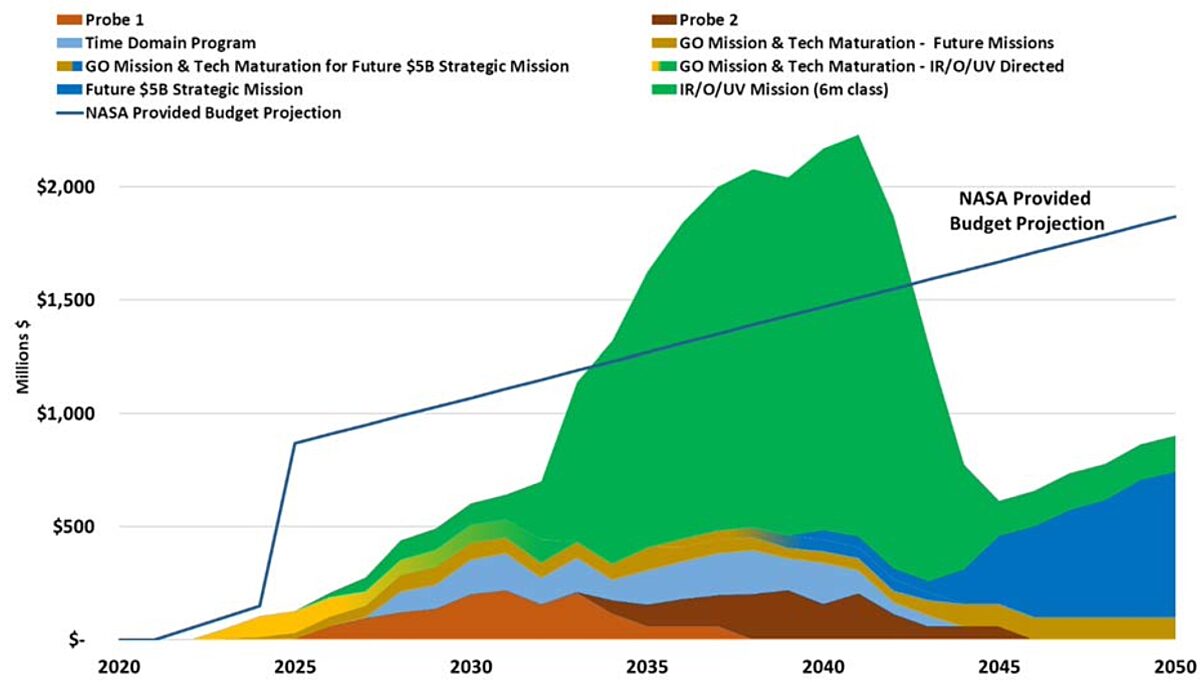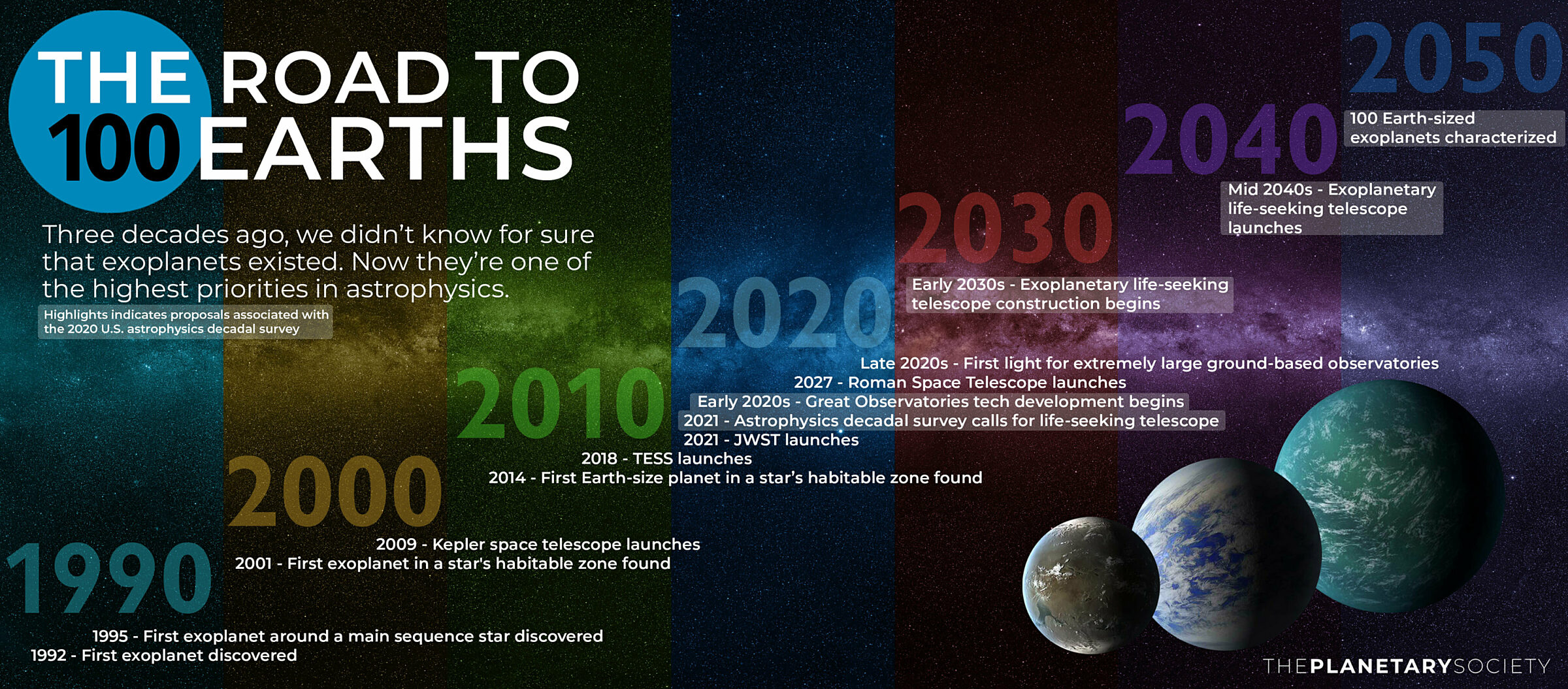Casey Dreier • Dec 03, 2021
Your Guide to the 2020 Astrophysics Decadal Survey
The future, if we want it
Imagine a space telescope twice the diameter of Hubble. Imagine it with exquisite instrumentation not yet invented, capable of scanning the atmospheres of exoplanets — Earth-sized ones; perhaps hundreds of them — for biosignatures, signs of life. Imagine finding this in our lifetime.
This dream is now the consensus goal of the United States’ astronomy community, as outlined in a new report released by the prestigious National Academies of Sciences, Engineering, and Medicine.
Their ambitions go further: a new fleet of space-based “great observatories” spanning the electromagnetic spectrum from infrared to x-rays. A new program of mid-sized space telescopes. New, ground-based extremely large telescopes and upgraded radio, neutrino, and gravitational wave observatories. Investments in scientists and active efforts to recruit a more diverse workforce.
These are the headline recommendations from “Pathways to Discovery in Astronomy and Astrophysics for the 2020s,” colloquially known as the decadal survey, released in November 2021. NASA and the National Science Foundation generally follow these recommendations, and the U.S. Congress generally funds the top priorities. As a consequence, this report will shape the next two decades of astronomy in the United States and, because of regular international collaborations on major projects, the rest of the world as well.
It’s a big deal.
This guide summarizes key takeaways from this report, with a particular emphasis on areas relevant to The Planetary Society — namely the search for life and exoplanetary research. It also provides the context necessary to understand the motivations behind these recommendations.
It all starts with the questions
It’s easy to focus on the multi-billion dollar projects, the proposed observatories, and sleek hardware and future programs. But that overlooks the core of the decadal survey: the science, the ultimate motivation behind these proposed projects.
Decadal surveys identify the most promising avenues of scientific research, establishing the foundation of all further recommendations and proposals in the report. By first agreeing on the questions, scientists can then determine the tools and methods they need to answer them.
The 2020 astrophysics decadal survey defines three priority science areas:
- Pathways to habitable worlds
Finding and characterizing Earth-like exoplanets that could harbor life. - New windows on the dynamic universe
Understanding rapid, powerful events (such as neutron star collisions) over time using gravitational waves, neutrinos, and the full electromagnetic spectrum. - Unveiling the drivers of galaxy growth
Unlocking the secrets of how galaxies form and gain complexity, and how their surroundings, black holes, and other inputs drive their evolution.
All of the report's recommendations derive from these key scientific questions.
Prioritizing the tools to answer the questions
Once the questions are properly defined, the report goes on to outline the tools and programs necessary to answer them. These include:
- Continue existing programs and those under active development (including the Roman Space Telescope, JWST, and the Vera C. Rubin Observatory). The one exception is SOFIA, NASA’s flying telescope platform, which is declared to be scientifically unproductive and not worth the ongoing costs of operation.
- Develop a 6-meter (20-foot, JWST-sized) telescope capable of detecting biosignatures in the atmospheres of roughly 100 Earth-sized exoplanets, in addition to other useful science, launching by the mid-2040s.
- Initiate a new Great Observatories Technology Maturation Program to lower the risk and cost of future space telescope programs.
- Begin a new “mid-sized” ($1.5 billion) space telescope program, with the goal of launching one per decade.
- Complete at least one extremely large ground-based telescope (either the Thirty Meter Telescope or the Giant Magellan Telescope, but ideally both)
- Invest in the scientific community, and improve efforts to recruit a more diverse workforce
The report goes to great lengths to demonstrate how each recommendation will directly support the major science themes. For example, a space telescope needs to have a diameter of at least 6 meters across to be sensitive enough to survey ~100 Earth-sized exoplanets for biosignatures. These biosignatures are only visible in certain wavelengths of light, which is why the telescope must be able to measure a range from infrared to ultraviolet (unlike JWST, which is sensitive primarily in mid-infrared). The scientific goals drive the requirements.
Astronomy doesn’t happen in a vacuum
The authors of the decadal survey are aware of the budgetary and political uncertainties inherent in public funding, and their recommendations implicitly acknowledge the consequences of costly program overruns from JWST, the Roman Space Telescope, and the high operating costs of new ground-based observatories.
As part of the decadal process, NASA commissioned an independent cost estimate for several large space telescope mission concepts, with outcomes ranging from $5 to $17 billion. The ultimate recommendation, the 6-meter “Super Hubble”, has a rough cost estimate of $11 billion.
That’s expensive, but it’s not unprecedented. Both the Hubble and JWST cost similar amounts when adjusted for inflation. But work cannot begin right away. The Roman Space Telescope, the top recommendation of the 2010 astrophysics decadal survey, was delayed by the cost overruns of JWST and is only now reaching its peak development period. It will not launch until 2027. Absent an unlikely doubling of the astrophysics budget, NASA cannot afford to start any next-generation space telescope projects until after Roman, in the late 2020s.
The decadal survey acknowledges this reality and concludes that the next great space observatory effort will extend into the next decadal period of the 2030s, and not launch until the mid-2040s.
The budget situation will still be a challenge, even after waiting to finish the Roman Space Telescope. NASA’s Astrophysics budget will likely have to be significantly augmented to support the next-generation space telescope, as seen in the following chart included in the decadal survey.

In an attempt to be fiscally realistic but still move the project forward, the report recommends an interim solution: the “Great Observatories Mission and Technology Maturation Program,” a decade-long effort to design and test critical technologies for the next generation of space telescopes. The report recommends that NASA spend roughly $100 million per year on this effort, far less than the cost of a full development program. The next decadal survey, in 2030, can then evaluate the progress and recommend (or not) a full commitment to the project.
This extended formulation approach has the benefit of minimizing the financial risk to NASA, investing in important technologies that will be broadly useful to astronomy, and queues up a clear successor to the Roman Space Telescope.
At the same time, absent major investments, the program will remain vulnerable to cancellation or cutbacks — it’s always easier, politically, to underfund nascent efforts than ones with established coalitions and vested interests. But absent an explosion in astrophysics funding, it is a risk the community is willing to take.
Thinking Big
In our official recommendation to the decadal survey working group, The Planetary Society urged the community to “think big” and prioritize the search for life. They did so. The proposed telescope, the yet-to-be-named Super Hubble, will enable a statistically significant survey of Earth-like exoplanets for the first time in human history.
It is relevant to consider how new this all is: confirmation of the first-ever exoplanet happened a mere 30 years ago. Now, exoplanetary research occupies the highest-priority recommendation of the centuries-old field of astronomy. It’s a remarkable development that many of us have witnessed entirely within our lifetimes.

The outcome of a large-scale search for biosignatures could be transformative, and even the absence of a detection provides valuable context and excellent science. A pathway to scientific revolution lies before us.
If we want it, that is.
For all the weight and respect carried by the decadal survey, it remains a set of non-binding recommendations. NASA and the National Science Foundation have to balance the needs of astrophysics against their other science programs and against ever-evolving needs of the nation. And at the end of the day, the process of science relies on the availability of dollars and cents; the U.S. Congress will be the ultimate enabler (or deterrent) to this one potential avenue of our scientific knowledge.
But Congress works for their constituents. If you live in the United States, you have the right to share your priorities with your representatives. Organizations like The Planetary Society work every day to engage with them on your behalf, to demonstrate that yes, there is public support for grand ambitions outlined in this report, to push against our boundaries of ignorance and seek answers to a fundamental question we all ask ourselves: are we alone?
The science case has been made. There is a pathway to discovery ahead. It is our job to make sure we take it.
Support our core enterprises
Your support powers our mission to explore worlds, find life, and defend Earth. You make all the difference when you make a gift. Give today!
Donate

 Explore Worlds
Explore Worlds Find Life
Find Life Defend Earth
Defend Earth

